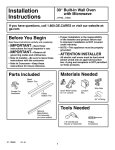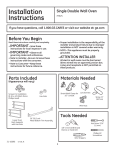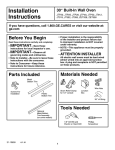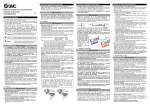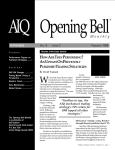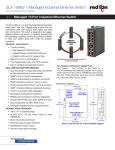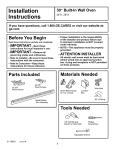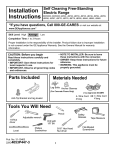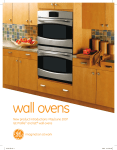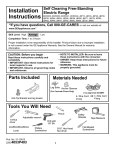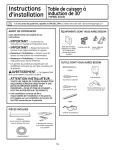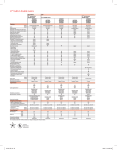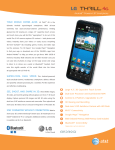Download Installation Instructions
Transcript
Installation Instructions Built-In Wall Oven with Microwave 27” (68.6 cm) model JKP90 30” (76.2 cm) models JTP90, PT970 If you have questions, call 1.800.GE.CARES or visit our website at: ge.com Before You Begin • Proper installation is the responsibility of the installer and product failure due to improper installation is NOT covered under warranty. • NOTE—This appliance must be properly grounded. Read these instructions carefully and completely. • IMPORTANT—Save these instructions for local inspector’s use. • IMPORTANT—Observe all • governing codes and ordinances. • Note to Installer—Be sure to leave these instructions with the consumer. • Note to Consumer—Keep these instructions for future reference. ATTENTION INSTALLER All electric wall ovens must be hard wired (direct wired) into an approved junction box. A plug and receptacle is NOT permitted on these products. Materials Needed Parts Included (Appearance will vary.) Wire Nuts Screws For Installation (8-18 x .750 flat head Phillips wood screws) Strain Relief Clamp for 1/2” conduit 27″ (68.6 cm) Metal Bottom Trim Junction Box 36” (91 cm) of String Tools Needed Optional 27″ (68.6 cm) Metal Bottom Trim Assembly (on some models or can be purchased separately) 31-10648 30″ (76.2 cm) Metal Bottom Trim Assembly 1/8” Drill Bit and Electric or Hand Drill 02-07 JR 1 Phillips Screwdriver Installation Instructions IMPORTANT SAFETY INSTRUCTIONS For Your Safety Electrical Requirements (cont.) • Be sure your oven is installed properly by a qualified installer or service technician. • Be sure the oven is securely installed in a cabinet that is firmly attached to the house structure. Weight on the oven door could cause the oven to tip and result in injury. Never allow anyone to climb, sit, stand or hang on the oven door. • Make sure the cabinets and wall coverings around the oven can withstand the temperatures (up to 200°F [93.3°C]) generated by the oven. Rating plate is located on the inside wall of the microwave oven. Rating Plate Location We recommend you have the electrical wiring and hookup of your oven connected by a qualified electrician. After installation, have the electrician show you where your main oven disconnect is located. Check with your local utilities for electrical codes which apply in your area. Failure to wire your oven according to governing codes could result in a hazardous condition. If there are no local codes, your oven must be wired and fused to meet the requirements of the National Electrical Code, ANSI/ NFPA No. 70–Latest Edition. You can get a copy by writing: National Fire Protection Association Batterymarch Park Quincy, MA 02269 Effective January 1, 1996, the National Electrical Code requires that new, but not existing, construction utilize a four-conductor connection to an electric oven. When installing an electric oven in new construction, a mobile home, recreational vehicle or an area where local codes prohibit grounding through the neutral conductor, follow the instructions in the section on NEW CONSTRUCTION AND FOUR-CONDUCTOR BRANCH CIRCUIT CONNECTION. You must use a three-wire, single-phase A.C. 208Y/120 Volt or 240/120 Volt, 60 hertz electrical system. If you connect to aluminum wiring, properly installed connectors approved for use with aluminum wiring must be used. WARNING: The electrical power to the oven supply line must be shut off while line connections are being made. Failure to do so could result in serious injury or death. Electrical Requirements This appliance must be supplied with the proper voltage and frequency, and connected to an individual, properly grounded branch circuit, protected by a circuit breaker or fuse. See the rating plate located on the oven frame to determine the rating of the product. Use the chart below to determine the minimum recommended dedicated circuit protection. KW Rating 240V ≤4.8 KW 4.9 KW–7.2 KW 7.3 KW–9.6 KW 9.7 KW–12.0 KW KW Rating 208V ≤4.1 KW 4.3 KW–6.2 KW 6.3 KW–8.3 KW 8.4 KW–10.4 KW Recommended Circuit Size (Dedicated) 20 Amp 30 Amp 40 Amp 50 Amp 2 Installation Instructions Pre-Installation Checklist Door removal is not a requirement for installation of the product, but is an added convenience. To remove the door: Remove packaging materials. Check inside microwave, behind hinges and under false bottom. Remove labels on the outside of the door, plastic on trims and panel, all tape around the oven and any shipping screws securing the oven to the base pad. Open the oven door as far as it will go. Push both hinge locks down toward Hinge the door frame, Hinge Slot Slot to the unlocked position. This may require a flat blade screwdriver. Hinge Hinge Unlocked Unlocked Position Position Hinge Hinge Arm Arm DO NOT LIFT THE DOOR BY THE HANDLE! Place hands on both sides of the door, and close the oven door to the removal position, which is most of the way closed. Lift door up and out until the hinge arms clear the slots. Oven Racks EASY INSTA LLA TIO EASY INSTALLATION OFNYOUR NEW Before 30" IMPOR you begin WALL OF YO 30" -Read WALL OVEN IMPOR TANTOVEN UR NE Save these Note TANTinstru OBSE these W to instru Install ctions OWNE RVE instructions Before you begin-Read completely and carefully. er- Bethese comp ALL ctions Note- R- Keep for inspector’s GOVE these sure instructions for local IMPORTANTletelyuse. ThisSave these to leave RNINGlocal inspec and applia IMPORTANT- OBSERVE ALL GOVERNING CODES AND ORDIANCES. instru carefu CODE these nce tor’s ctions Note to Installer- Be suremust to leave these with the consumer. S AND instru use. lly. for instructions be ctions future ORDIA OWNER- Keep these instructionsprope for future reference. with rly grounrefere FOR the NCES. Note- This appliance must be properly grounded (if applicable). nce. YOUR consu ded SAFE (if applic mer. Before TY able). instru you begin carefu ctions comp-Read ELECTRICAL REQUIREMENTS lly. YOUR SAFETY IMPORFOR letely these and ELEC instru TANTTRICA ctionsyouSave Before begin-Read IMPOR Before you begin-Read these these L REQU these Before TANT for local completely and GOVEinstructions IREME instructions completely and instru you begin RNING - OBSE inspec NTS Note carefully. tor’s carefully. RVE to Install CODE Save carefu ctions comp-Read use. ALL these IMPORTANTS ANDthese IMPORTANT- Save these er- Befor IMPOR lly. letely these instructions local inspector’s use. OWNE instru instructions for localand inspector’s use. ctions sure ORDIANCES instru TANTR-IMPORTANTto leave OBSERVE ALL for future Keep with Save OBSERVE ALL IMPORTANTctions . the AND ORDIANCES. IMPOR these CODES these NoteGOVERNING refere instru consu TANT for localCODES AND ORDIANCES. GOVE GOVERNING ctions prope ThisNote inspec - OBSE tonce. Installer- Be sure mer. to leave applia Note to InstallerBe sure to leave rly Note RNING tor’s RVE nce Before groun these instructions with the consumer. to these CODE instructionsALL with theuse. consumer. these Install ded must be S AND instru youOWNERKeep these instructions er- Be begin (if applic OWNERKeep these instructions OWNE instru sure ORDIA ctions -Read carefu ctionsfor able). future reference. R- Keep comp to leave NCES for futurewith reference. for future these . IMPOR lly. Note- This letelyappliance must be the Note-these This appliance must be Noterefere and instru consumer. instru TANT-properly grounded (if applicable). prope This properly nce. grounded (if applicable). Save ctions applia IMPORctions for Beforethese you begin-Read these nceyou begin-Read these Before Beforerly groun local GOVE TANT- instructions ded mustcompletely instructions and OBSE inspeccompletely and instru you begin (if applicbe Note RNING carefully. -Read CODE RVE ALL tor’s use. carefully. carefu ctions comp to able). these Install IMPORTANTS AND Save these erIMPOR lly. letely these IMPORTANTSave these OWNE instructionsBe sure ORDIA andfor local inspector’s use. instructions for local use. TANT instructions NCESinspector’sinstru R- Keep to leave for future with . ALL IMPORctions - Save IMPORTANTOBSERVE the these IMPORTANTOBSERVE ALL these for local Noterefere instru consu GOVERNING CODES AND ORDIANCES. GOVE TANTGOVERNING CODES AND ORDIANCES. inspec ctions mer. prope This appliance. OBSE Note RNING rly groun nceNote to Installer- Be sure to leave tor’s Be sure to leave RVE Note to InstallerCODE to use. ALL must instructions with the consumer. these Install ded these S AND instructions with the consumer. er- these (if applicbe OWNE instructionsBeOWNEROWNER- Keep these instructions sure ORDIA Keep these instructions able). R- Keep to leave NCES for future with for future reference. reference. . the thesefor future Noteconsu refere Note- This appliance must be instruThis Noteappliance must be ctions mer. prope This appliance. properly grounded (if applicable). rly groun nce properly grounded (if applicable). ded must be (if applic able). Literature Pack Open oven door and remove literature pack and oven racks. Open microwave door and remove shelves and turntable package. Hinge Clears Slot Remove Installation Instructions from literature pack and read them carefully before you begin. Be sure to place all literature, Owner’s Manual, Installations, etc. in a safe place for future reference. NOTE: The oven door is very heavy. Be sure you have a firm grip before lifting the oven door off the hinges. Use caution once the door is removed. Do not lay the door on its handle. This could cause dents or scratches. Place the oven on a table or platform even with the cutout opening. (Platform must support 255 lbs. [115 Kg].) Remove the bottom trim from the top of the oven. It will be installed at the end of the installation process. The trim is wrapped separately and taped to the top of the unit. 3 Installation Instructions A Cutout for 27″ (68.6 cm) Built-In Oven with Microwave models only For JKP90 model only. 5” (12.7 cm) Max. from the left or right Junction Box Cabinet side Location Width 27” (68.6 cm) Cutout Width 25” (63.5 cm) Min. 25 1/4” (64.1 cm) Max. Allow 1” (2.5 cm) for overlap of oven over side edges of cutout Allow a minimum of 20” (50.8 cm) for clearance to adjacent corners, drawers, walls, etc. when door is open 2” x 4” (5 cm x 10 cm) or equivalent runners level with bottom of cutout 35” (88.9 cm) Cutout Min. Above Height base rail 41 1/8” (104.5 cm) Min. 41 1/4” (104.8 cm) Max. Alternate Junction Box Location (access from adjacent cabinet may be required) 5” Min. (12.7 cm) 20” (50.8 cm) Allow minimum 1” (2.5 cm) for overlap of oven top and bottom of cutout Recommended cutout location from floor 21 5/8” (54.9 cm) Cabinet Width 27” (68.6 cm) Recommended Cutout Location from Floor 21 5/8” (54.9 cm) Cutout Depth 23 1/2” (59.7 cm) Cutout Width 25” (63.5 cm) Min. 25 1/4” (64.1 cm) Max. Cutout Height 41 1/8” (104.5 cm) Min. 41 1/4” (104.8 cm) Max. NOTE: If the cabinet does not have a front frame and the sides are less than 3/4” (1.9 cm) thick, shim both sides equally to establish the cutout width. 2” x 4” (5 cm x 10 cm) 2" x 4" or runners or equivalent Equivalent level with bottom of Runners cutout If the cabinet does not have a solid bottom, two braces or runners must be installed level with the bottom of the cutout to support the weight of the oven. The runners and braces must support 255 lbs (115 Kg). 24” (61 24" cm) NOTE: If marks, blemishes or the cutout opening are visible above the installed oven, it may be necessary to add wood shims under the runners and front trim until the marks or opening are covered. 18” 18" (45.7 cm) 27" 27” (68.6 cm) NOTE: If using equivalent runners, then the center of the equivalent runners should be 20 1/2” (52.1 cm). 4 Installation Instructions A Cutout for 30″ (76.2 cm) Built-In Oven with Microwave models only For JTP90, PT970 models only. Cabinet *CABINET Width WIDTH 30" cm) 30” (76.2 Allow 11/16” (1.8 cm) for overlap of oven ALLOW 11/16" over side edges of FOR OVERLAP OF OVEN OVER cutout Cabinet Width 20” (50.8 cm) Max. 20" Cutout Width CUTOUT WIDTH 28 1/2” 28 1/2" MIN. (72.4 cm) Min. 28 5/8" MAX. 28 5/8” (72.8 cm) Max. Junction Box JUNCTION BOX Location LOCATION SIDE EDGES OF CUTOUT. A MINIMUM Allow ALLOW a minimum of 21” OF 21" FOR CLEARANCE (53.3 for clearance TOcm) ADJACENT CORNERS, to adjacent corners, DRAWERS, WALLS, ETC. WHEN DOORS OPENED. drawers, walls,ARE etc. when door is open 21" 21” (53.3 cm) Opening between inside walls THE OPENING BETWEEN must be INSIDE at WALLS MUST least 1/2” BE A28 LEAST 28 1/2" WIDE (72.4 cm) wide ALLOW 1" FOR Allow minimum 1” OVERLAP (2.5 cm)OF for overlap OVEN TOP of ovenAND top BOTTOM and 11⁄4” CUTOUT. (3.2 cm)OF overlap of bottom of cutout Cutout Height 42 3/16” (107.2 cm) Min. CUTOUT 42 HEIGHT 1/4” 42 3/16"cm) MIN. (107.3 42 1/4" MAX. Max. 28” (71.1 28" cm) Min. TO to BOTTOM OF of Bottom JUNCTION BOX Junction Box 30” (76.2 cm) Recommended Cutout Location from Floor 21 5/8” (54.9 cm) Cutout Depth 23 1/2” (59.7 cm) Min. Cutout Width 28 1/2” (72.4 cm) Min. 28 5/8” (72.8 cm) Max. Cutout Height 42 3/16” (107.2 cm) Min. 42 1/4” (107.3 cm) Max. NOTE: If the cabinet does not have a front frame and the sides are less than 3/4” (1.9 cm) thick, shim both sides equally to establish the cutout width. RECOMMENDED Recommended cutout CUTOUT from floor location LOCATION 21215/8” 5/8" (54.9 cm) If the cabinet does not have a solid bottom, two braces or runners must be installed level with the bottom of the cutout to support the weight of the oven. The runners and braces must support 255 lbs (115 Kg). CL 2”xx4"4” 2" or EQUIVALENT (5 cm x 10 cm) RUNNERS or equivalent runners level with bottom of cutout NOTE: If marks, blemishes or the cutout opening are visible above the installed oven, it may be necessary to add wood shims under the runners and front trim until the marks or opening are covered. Suitable Bracing to Support Runners 21 5/8” 5/8" 21 OVER CENTERLINE (54.9 cm) OF CABINET Over Centerline of Cabinet 5 Installation Instructions A Cutout for Built-In Oven with Microwave models only – Over a Warming Drawer For JKP90, JTP90, PT970 models only. 30″ (76.2 cm) Oven with Microwave Oven (Models JTP90 and PT970) Over a Warming Drawer 27″ (68.6 cm) Oven with Microwave Oven (Model JKP90) Over a Warming Drawer Anti-Tip Block Against Rear Wall Per Warming Drawer Requirement 3” (7.6 cm) Min. Per Warming Drawer Requirement Anti-Tip Block Against Rear Wall Per Warming Drawer Requirement 2” (5.1 cm) Min. Per Warming Drawer Requirement 1” (2.5 cm) Min. Above Toekick NOTE: Install the oven only with specific models listed on the label 1” (2.5 cm) Min. Above Toekick located on top of the oven. • When installing a Warming Drawer below a single or double oven, a separate 120V, 60 Hz, properly grounded receptacle must be installed. Refer to installation instructions packed with the Warming Drawer for specific installation requirements. NOTE: Additional clearances between cutouts may be required. Check to be sure the oven supports above the Warming Drawer location do not obstruct the required interior depth and height. 6 Installation Instructions B Electrical Connections ATTENTION INSTALLER All electric wall ovens must be hard wired (direct wired) into an approved junction box. A plug and receptacle is NOT permitted on these products. DO NOT shorten the flexible conduit. The conduit strain relief clamp must be securely attached to the junction box and the flexible conduit must be securely attached to the clamp. If the flexible conduit will not fit within the clamp, do not install the oven until a clamp of the proper size is obtained. NOTE TO ELECTRICIAN: The 3 power leads supplied with this appliance are UL recognized for connection to heavier gauge household wiring. The insulation of these 3 leads is rated at temperatures much higher than the temperature rating of household wiring. The current carrying capacity of the conductor is governed by the wire gauge and the temperature rating of the insulation around the wire. B1 Turn off the circuit breaker or remove fuses to the oven branch circuit. B2 With the oven supported on a table or platform in front of the cabinet opening, connect the flexible conduit to the electrical junction box as shown below. Position the conduit in such a manner that it will lie on top of the oven in a natural loop when the oven is installed. You will need to purchase an appropriate strain relief clamp to complete the connection of the conduit to the junction box. Junction Box Location Conduit GROUND WIRE BARE GROUND WARNING: Improper connection of aluminum house wiring to copper leads can result in an electrical hazard or fire. Use only connectors designed for joining copper to aluminum and follow the manufacturer’s recommended procedure closely. RED WHITE BLACK Strain Relief Clamp (not included) must be used at Junction Box Place oven on a support to assist in connecting conduit 7 (Continued on following page) Installation Instructions B Electrical Connections cont. B3 New Construction and Four-Conductor Branch Circuit Connection B4 Three-Conductor Branch Circuit Connection When connecting to a three-conductor branch circuit, if local codes permit: • When installing in new construction, or a. Connect the bare oven ground conductor with the crimped neutral (white) lead to the branch circuit neutral (white or gray in color), using a wire nut. • When installing in a mobile home, or • When installing in a recreational vehicle, or • When local codes do not permit grounding through neutral: a. Cut the neutral (white) lead from the crimp. Re-strip the neutral (white) lead to expose the proper length of conductor. Ground and Neutral Wires Ground Wire Junction Box Cover b. Connect the oven red lead to the branch circuit red lead in accordance with local codes, using a wire nut. Junction Box Cover c. Connect the oven black lead to the branch circuit black lead in accordance with local codes, using a wire nut. If the residence red, black or white leads are aluminum conductors, see WARNING on page 7. b. Attach the appliance grounding lead (green or bare copper) in accordance with local codes. If the residence grounding conductor is aluminum, see WARNING on page 7. d. Install Junction Box Cover. c. Connect the oven neutral (white) lead to the branch circuit neutral (white or gray) in accordance with local codes, using a wire nut. d. Connect the oven red lead to the branch circuit red lead and the oven black lead to the branch circuit black lead in accordance with local codes, using wire nuts. If the residence red, black or white leads are aluminum conductors, see WARNING on page 7. e. Install Junction Box Cover. 8 Installation Instructions C Securing the Oven in the Opening C1 Sliding the Oven Into the Opening C2 Drilling the Pilot Holes and Mounting the Oven a. Loop (do not tie) a 36” (91 cm) string around the conduit before the oven is slid into place. This will keep the conduit from falling behind the oven. NOTE: Before drilling the pilot holes, make sure the oven is pushed as far back into the opening as it will go and centered. a. Drill through the mounting holes (top and bottom) of the side trim, for the #8 screws provided. Pull out on string loop while pushing the oven into the cabinet Mounting Hole Locations (Hole Locations may vary) The screws must be a minimum of 1/4” (6 mm) from the front of the cutout. WARNING: Mounting b. Lift oven into cabinet cutout using the oven opening as a grip. Carefully push against oven front frame. Do not push against outside edges. screws must be used. Failure to do so could result in the oven falling out of the cabinet causing serious injury. c. As you slide the oven back, pull the string so that the conduit will lie on top of the oven in a natural loop. b. Secure the oven to cabinet with screws provided. d. When you are sure the conduit is out of the way, slide the oven 3/4 way back into the opening. Remove the string by pulling on one end of the loop. NOTE: If the cabinet is particle board, you must use #8 x 3/4” particle board screws. These may be purchased at any hardware store. 9 (Continued on following page) Installation Instructions C3 Preparing for the Bottom Trim Installation C4 Installing the Metal Bottom Trim a. With oven installed, take the bottom trim and center it on the bottom front edge of the cabinet opening. a. Place the bottom metal trim centered over the pre-drilled mounting holes. Tape the edges of the trim down to maintain the alignment. 27″ (68.6 cm) b. Using the trim For models with Lower as a template, Trim in Position, (2) Mounting mark the center Mark Hole Locations here of each slot (two total) where the mounting holes will be drilled. c. Remove the trim. d. Drill pilot holes into the center of each template mark. * Remove Lower Trim Before Pre-drilling Mounting Holes b. Using two trim screws provided, secure the bottom trim to the bottom edge of the cabinet. Trim Screw Locations for 27″ (68.6 cm) models with Lower Trim * For 30″ (76.2 cm) models with Lower Trim in Position, Mark (2) Mounting Hole Locations here Side Trim Side Trim Metal Lower Trim Trim Screw Locations for 30″ (76.2 cm) models with Lower Trim IMPORTANT: If this unit is ever removed from the cabinet or the oven is ever pulled out for service, the trim must be removed first or damage to the trim will occur. 10 Installation Instructions D Replacing the Oven Door NOTE: The oven door is heavy. You may need help lifting the door high enough to slide it into the hinge slots. Do not lift the door by the handle. D1 D3 Open the oven door as far as it will open. D4 Push the hinge locks up against the front frame of the oven cavity, to the locked position. Hinge in Locked Position Lift the oven door by placing one hand on each side. The door is heavy, so you may need help. Do not lift the door by the handle. Notch of Hinge Securely Fitted into Bottom of Hinge Slot D5 D2 With the door at the same angle as the removal position, which is most of the way closed, seat the notch of the hinge arm into the bottom edge of the hinge slot. The notch of the hinge arm must be fully seated into the bottom of the slot. Hinge Arm Bottom Edge of Slot Hinge Notch 11 Close the oven door. Installation Instructions Pre-Test Checklist Remove all protective film, if present, and any stickers. Check that the bottom trim is installed properly (see page 10). Check to be sure that all wiring is secure and not pinched or in contact with moving parts. Check to be sure the mounting screws are installed and flush with the side trim (see page 9). Operation Checklist Remove all items from the inside of the oven. NOTE TO ELECTRICIAN: The power leads supplied with this appliance are UL recognized for connections to larger gauge household wiring. The insulation of these leads is rated at temperatures much higher than the temperature rating of household wiring. The current carrying capacity of a conductor is governed by the wire gauge and also the temperature rating of the insulation around the wire. Check that conduit is securely connected to the junction box. Turn on the power to the oven. (Refer to your Owner’s Manual.) Verify that the bake and broil units, and all cooking functions operate properly. Check that the circuit breaker is not tripped nor the house fuse blown. NOTE: ALUMINUM WIRING See your Owner’s Manual for troubleshooting list. WARNING: IMPROPER CONNECTION OF ALUMINUM HOUSE WIRING TO THE COPPER LEADS CAN RESULT IN AN ELECTRICAL HAZARD OR FIRE. B. Splice copper wires to aluminum wiring using special connectors designed and UL approved for joining copper to aluminum, and follow the manufacturer’s recommended connector procedure closely. NOTE: Wire used, location and enclosure of splices, etc., must conform to good wiring practice and local codes. A. 12 Instrucciones de instalación Horno de pared empotrado con microondas Modelo de 27” (68,6 cm) JKP90 Modelo de 30” (76,2 cm) JTP90, PT970 ¿Preguntas? Visite nuestro sitio en la Web: ge.com Antes de empezar instrucciones y téngalas disponibles para el inspector local. • La instalación apropiada es responsabilidad del instalador y la falla del producto por una instalación incorrecta NO está cubierta por la garantía. • NOTA—Este aparato debe estar conectado a tierra adecuadamente. IMPORTANTE—Observe todos • Lea estas instrucciones cuidadosa y completamente. • • IMPORTANTE—Guarde estas los códigos y ordenanzas vigentes. • Nota al instalador—Cerciórese de dejar estas instrucciones con el propietario. • Nota al consumidor—Guarde estas instrucciones para usarlas como referencia en el futuro. ¡ATENCIÓN AL INSTALADOR! Todos los hornos electrónicos de pared deben ser cableados directamente en una caja de conexión aprobada. Un “enchufereceptáculo” NO ES permitido en estos productos. Materiales necesarios Partes incluidas (la apariencia puede variar.) Tornillos para instalación (tornillos para madera tipo Phillips de cabeza plana 8-18 x .750) Abrazadera de alivio de presión para conducto de 1/2” Moldura de fondo metálica de 27″ (68,6 cm) Cordón de 36” (91 cm) Herramientas necesarios Montaje de moldura Montaje de moldura de de fondo metálica fondo metálica de 30″ opcional de 27″ (76,2 cm) (68,6 cm) (en algunos modelos pueden adquirirse por separado) 31-10648 Caja de conexión Tuercas para alambres Una broca de 1/8” para taladro eléctrico o manual 02-07 JR 1 Destornillador de estrella Instrucciones de instalación INSTRUCCIONES DE SEGURIDAD IMPORTANTES Para su seguridad Requisitos eléctricos • Cerciórese de que su horno sea instalado adecuadamente por un instalador calificado o por un técnico de servicio. • Cerciórese de que su horno esté firmemente instalado en un gabinete que esté firmemente adherido a la estructura de la casa. El peso sobre la puerta del horno podría causar que el horno se voltee resultando en lesiones. Nunca permita que nadie se suba, se siente, se pare o se cuelgue de la puerta del horno. • Cerciórese de que los gabinetes y los revestimientos de la pared alrededor del horno puedan soportar las temperaturas (hasta 200°F [93,3°C]) generadas por el horno. (cont.) La tabla de valores está ubicada en el pared interior del microondas. Ubicación de la tabla de valores Recomendamos que el cableado y la conexión eléctrica de su horno los realice un electricista calificado. Después de la instalación, pída al electricista que le muestre la ubicacion del interruptor principal del horno. Consulte con su compañía de servicios local para obtener los códigos eléctricos que sean aplicables en su área. No hacer el cableado de su horno de manera apropiada, respetando los códigos vigentes, podría resultar en condiciones peligrosas. Si no existen códigos locales, su aparato debe usar un cableado y fusibles que cumplan con los requisitos, del Código Eléctrico Nacional, ANSI/NFPA No. 70–Última edición. Usted puede obtener una copia de este código escribiendo a: National Fire Protection Association Batterymarch Park Quincy, MA 02269 A partir del 1ro. de enero de 1996, el Código Eléctrico Nacional requiere que todas las construcciones nuevas, pero no existentes, usen una conexión de 4 conductores hacia cualquier horno eléctrico. Cuando instale un horno eléctrico en una construcción nueva, casa móvil, vehículo de recreación o un área donde los códigos locales prohíban la conexión a tierra a través del conductor neutro, siga las instrucciones en la Sección CONSTRUCCIONES NUEVAS Y CONEXIONES DE CIRCUITOS RAMALES DE 4 CONDUCTORES. Usted debe usar un sistema eléctrico de tres alambres, monofásico, A.C. 208Y/120 voltios o 240/120 voltios, 60 Hertz. Si hace una conexión a alambres de aluminio, debe usar conectores adecuadamente instalados que estén aprobados para ser utilizados con cableados de aluminio. ADVERTENCIA: La energía eléctrica hacia la línea de suministro del horno debe ser desconectada mientras se hacen las conexiones. No hacer esto podría resultar en lesiones graves e incluso provocar la muerte. Requisitos eléctricos Este aparato debe abastecerse con la frecuencia y el voltaje adecuados, y conectarse a un circuito eléctrico individual con conexión a tierra con protección de un fusible o interruptor automático. Consulte la placa de potencia ubicada en el marco del horno para determinar la potencia del producto. Utilice el cuadro a continuación para determinar la protección mínima recomendada para el circuito eléctrico especializado. Recomendable Potencia KW Potencia KW Tamaño del circuito 240V 208V (Especializado) ≤4,8 KW ≤4,1 KW 20 Amp 4,9 KW–7,2 KW 4,3 KW–6,2 KW 30 Amp 7,3 KW–9,6 KW 6,3 KW–8,3 KW 40 Amp 9,7 KW–12,0 KW 8,4 KW–10,4 KW 50 Amp 2 Instrucciones de instalación Lista de control antes de la instalación No es necesario retirar la puerta para la instalación del producto, pero hacerlo facilita la instalación. Para retirar la puerta: Abra la puerta del horno hasta el máximo. Retire los materiales de embalaje. Revise dentro del microondas, detrás de las bisagras y debajo del fondo falso. Retire las etiquetas de la puerta, el plástico de las molduras y panel, todas las cintas alrededor del horno, y todos de los tornillos de envío que asegure el horno a la almohadilla de la base. Empuje los topes de las bisagras hacia abajo, hacia el marco de la puerta hasta la posición abierta. Esto podría requerir el uso de un destornillador plano. Hinge Posición Unlocked abierta de laPosition bisagra Hinge Ranura Slot de la bisagra Brazo Hinge de laArm bisagra ¡NO LEVANTE LA PUERTA POR LA EMPUÑADURA! Coloque las manos en ambos lados de la puerta y cierre la puerta del horno hasta la posición de remoción, que está cerrado la mayor parte del tiempo. Parrillas del horno EASY INSTA LLA TIO EASY INSTALLATION OFNYOUR NEW Before 30" OF WAOVEN 30" WALL LL OV YOUR NEW EN IMPOR you begin -Read IMPOR TANTSave these Note TANTthese instru to Install OBSE instru ctions OWNE RVE instructions Before you begin-Read completely and carefully. er- Bethese comp ALL ctions Note- R- Keep for inspector’s GOVE IMPORTANTthese sure instructions for local letelyuse. ThisSave these to leave RNINGlocal inspec and applia IMPORTANT- OBSERVE ALL GOVERNING CODES AND ORDIANCES. instru carefu CODE these nce tor’s ctions Note to Installer- Be suremust to leave these with the consumer. S AND instru use. lly. for instructions be ctions future ORDIA OWNER- Keep these instructionsprope for future reference. with rly grounrefere FOR the NCES. Note- This appliance must be properly grounded (if applicable). nce. YOUR consu ded SAFE (if applic mer. Before TY able). instru you begin carefu ctions comp-Read ELECTRICAL REQUIREMENTS lly. YOUR SAFETY IMPORFOR letely these and ELEC instru TANTTRICA ctionsyouSave Before begin-Read IMPOR Before you begin-Read these these L REQU these Before TANT for local completely and GOVEinstructions IREME instructions completely and instru you begin RNING - OBSE inspec NTS Note carefully. tor’s carefully. RVE to Install CODE Save carefu ctions comp-Read use. ALL these IMPORTANTS ANDthese IMPORTANT- Save these er- Befor IMPOR lly. letely these instructions local inspector’s use. OWNE instru instructions for localand inspector’s use. ctions sure ORDIANCES instru TANTR-IMPORTANTto leave OBSERVE ALL for future Keep with Save OBSERVE ALL IMPORTANTctions . the AND ORDIANCES. IMPOR these CODES these NoteGOVERNING refere instru consu TANT for localCODES AND ORDIANCES. GOVE GOVERNING ctions prope ThisNote inspec - OBSE tonce. Installer- Be sure mer. to leave applia Note to InstallerBe sure to leave rly Note RNING tor’s RVE nce Before groun these instructions with the consumer. to these CODE instructionsALL with theuse. consumer. these Install ded must be S AND instru youOWNERKeep these instructions er- Be begin (if applic OWNERKeep these instructions OWNE instru ctions sure ORDIANCES -Read carefu ctionsfor able). future reference. Rcomp for future reference. to for future Keep these with leave . IMPOR lly. Note- This letelyappliance must be the Note-these This appliance must be Noterefere and instru consumer. instru TANT-properly grounded (if applicable). prope This properly nce. grounded (if applicable). Save ctions applia IMPORctions for Beforethese you begin-Read these nceyou begin-Read these Before Beforerly groun local GOVE TANT- instructions ded mustcompletely instructions and OBSE inspeccompletely and instru you begin (if applicbe Note RNING carefully. -Read CODE RVE ALL tor’s use. carefully. carefu ctions comp to able). these Install IMPORTANTS AND Save these erIMPOR lly. letely these IMPORTANTSave these OWNE instructionsBe sure ORDIA andfor local inspector’s use. instructions for local use. TANT instructions NCESinspector’sinstru R- Keep to leave for future with . ALL IMPORctions - Save IMPORTANTOBSERVE the these IMPORTANTOBSERVE ALL these for local Noterefere instru consu GOVERNING CODES AND ORDIANCES. GOVE TANTGOVERNING inspec CODES AND ORDIANCES. ctions mer. prope This appliance. OBSE RNING Note rly groun nceNote to Installer- Be sure to leave tor’s Be sure to leave RVE Note to InstallerCODE to use. ALL must instructions with the consumer. these Install ded these S AND instructions with the consumer. er- these (if applicbe OWNE instructionsBeOWNEROWNER- Keep these instructions sure ORDIA Keep these instructions able). R- Keep to leave NCES for future with for future reference. reference. . the thesefor future Noteconsu refere Note- This appliance must be instruThis Noteappliance must be ctions mer. prope This appliance. properly grounded (if applicable). rly groun nce properly grounded (if applicable). ded must be (if applic able). Paquete de instrucciones Abra la puerta del horno y extraiga el paquete de instrucciones y las parrillas del horno. Abra la puerta del microondas y extraiga las parrillas y el paquete del plato giratorio. Levante la puerta y hale hacia fuera hasta que los brazos de la bisagra salgan de la ranuras. Bisagra sale de la ranura Extraiga las instrucciones de instalación del paquete y léalas cuidadosamente antes de empezar la instalación. Cerciórese de guardar bien todas las instrucciones, Manual del propietario, Instalación, etc. para referencia en el futuro. NOTA: La puerta del horno es muy pesada. Asegúrese de tenerla bien agarrada antes de levantarla de las bisagras. Tenga cuidado una vez que retire la puerta. No acueste la puerta sobre la empuñadura; esto podría causar marcas y rayas. Coloque el horno sobre la mesa o plataforma al nivel de la abertura del corte. (La plataforma debe soportar 255 libras [115 Kg].) Extraiga la moldura de fondo de la parte superior del horno. La misma será instalada al final de la instalación. La moldura de fondo está envuelta por separado y pegada a la parte superior de la unidad. 3 Instrucciones de instalación A Corte para el horno de pared empotrado de 27″ (68,6 cm) con microondas solamente Para el modelo JKP90 solamente. Permita 1” (2,5 cm) de sobrepaso del horno sobre los bordes laterales del corte 5” (12,7 cm) Máx. espacio para el lado izquierdo Ubicación de o derecho Ancho del la caja de gabinete conexión 27” (68,6 cm) Ancho del corte 25” (63,5 cm) Mín. 25 1/4” (64,1 cm) Máx. 2” x 4” (5 cm x 10 cm) o correderas equivalentes niveleada con el fondo del corte Permita un mínimo de 20” (50,8 cm) de espacio para las esquinas, cajones, paredes, etc., adyacentes cuando las puertas estén abiertas Altura 35” Mín. del corte (88,9 cm) 41 1/8” Sobre el riel (104,5 cm) de la base Mín. Conexión alterna 41 1/4” (104,8 cm) Ubicación de la caja–Puede requerirse el acceso desde Máx. el gabinete adyacente 5” (12,7 cm) Mín. 20” (50,8 cm) Permita un mínimo de 1” (2,5 cm) para el sobrepaso del horno por encima y debajo del corte Ubicación recomendada para el corte desde el piso 21 5/8” (54,9 cm) Ancho del gabinete 27” (68,6 cm) Ubicación recomendada para el corte desde el piso 21 5/8” (54,9 cm) Profundidad del corte 23 1/2” (59,7 cm) Ancho del corte 25” (63,5 cm) Mín. 25 1/4” (64,1 cm) Máx. Altura de corte 41 1/8” (104,5 cm) Mín. 41 1/4” (104,8 cm) Máx. NOTA: Si el gabinete no tiene un marco frontal y los lados son menores de 3/4” (1,9 cm) en grosor, coloque ambos lados en línea para establecer el ancho del corte. 2” x 4” 2" (5 x cm 10 cm) o 4"xor correderas equivalentes Equivalent niveleada con el fondo Runners del corte Si el gabinete no tiene un fondo sólido, entonces se deben instalar dos abrazaderas o correderas nivelada con el fondo del corte para sostener el peso del horno. Las correderas y abrazaderas deben soportar 255 libras (115 Kg). 24” (6124" cm) 18” 18" (45,7 cm) 27" 27” (68,6 cm) NOTA: Si las marcas, imperfecciones o la abertura del corte son visibles por encima del horno instalado, quizás sea necesario agregar relleno debajo de las correderas y moldura delantera hasta que se cubran. NOTA: Si usando las correderas equivalentes, el centro das correderas equivalentes debe estar 20 1/2” (52,1 cm). 4 Instrucciones de instalación A Corte para el horno de pared empotrado de 30″ (76,2 cm) con microondas solamente Para los modelos JTP90, PT970 solamente. *CABINET Ancho del WIDTH gabinete 30" 30” (76,2 cm) Permita 11/16” (1,8 cm) para sobrepaso del horno sobre los ALLOW 11/16" FOR bordes OVERLAPlaterales OF OVEN OVER del corte 20” 20" (50,8 cm) Máx. Ancho del corte CUTOUT 28 1/2” WIDTH (72,4 cm) Mín. 28 1/2" MIN. 28 5/8” 28 5/8" MAX. (72,8 cm) Máx. Ubicación JUNCTION BOX LOCATION de la caja de conexión SIDE EDGES OF CUTOUT. Permita un mínimo ALLOW A MINIMUM de 21” (53,3 cm) de OF 21" FOR CLEARANCE espacio para las CORNERS, esquinas, TO ADJACENT DRAWERS, WALLS, ETC. cajones, paredes, etc., WHEN DOORS ARE OPENED. adyacentes cuando las puertas estén abiertas Opening between inside walls THE OPENING must be BETWEEN INSIDE at leastMUST WALLS BE1/2” A LEAST 28 (72,4 28 1/2" WIDE cm) wide Altura del corte 42 3/16” (107,2 cm) Mín. 42 1/4” 28” 28" (71,1 cm) (107,3 cm) TO BOTTOM OF CUTOUT Mín. hasta JUNCTION BOX HEIGHT Máx. el fondo 42 3/16" MIN. 42 1/4" MAX. de la caja de conexión Ancho del gabinete 30” (76,2 cm) Ubicación recomendada para el corte desde el piso 21 5/8” (54,9 cm) Profundidad del corte 23 1/2” (59,7 cm) Mín. Ancho del corte 28 1/2” (72,4 cm) Mín. 28 5/8” (72,8 cm) Máx. Altura de corte 42 3/16” (107,2 cm) Mín. 42 1/4” (107,3 cm) Máx. 21" 21” (53,3 cm) Ubicación ALLOW 1" FOR Permita un mínimo OVERLAP de 1” OF (2,5 cm)TOP para OVEN AND BOTTOM el sobrepaso del OF CUTOUT. horno por encima y 1 1/4” (3,2 cm) para el sobrepaso del horno por debajo del corte RECOMMENDED recomendada para CUTOUT elLOCATION corte desde el 21 5/8" piso 21 5/8” (54,9 cm) Si el gabinete no tiene un fondo sólido, entonces se deben instalar dos abrazaderas o correderas nivelada con el fondo del corte para sostener el peso del horno. Las correderas y abrazaderas deben soportar 255 libras (115 Kg). NOTA: Si las marcas, imperfecciones o la abertura del corte son visibles por encima del horno instalado, quizás sea necesario agregar relleno debajo de las correderas y moldura delantera hasta que se cubran. NOTA: Si el gabinete no tiene un marco frontal y los lados son menores de 3/4” (1,9 cm) en grosor, coloque ambos lados en línea para establecer el ancho del corte. CL Abrazaderas de soporte adecuadas para las SUITABLE correderas BRACING TO SUPPORT RUNNERS 5 2118" 5/8” OVERcm) CENTERLINE (54,9 Sobre la OF CABINET línea de centro del gabinete 2”2"xx4” 4" or (5EQUIVALENT cm x 10 cm) RUNNERS o correderas equivalentes niveleada con el fondo del corte Instrucciones de instalación A Corte para el horno de pared empotrado con microondas solamente – Sobre una gaveta de calentamiento Para los modelos JKP90, JTP90, PT970 solamente. Horno de 30″ (76,2 cm) con microondas (modelos JTP90 y PT970) sobre una gaveta de calentamiento Horno de 27″ (68,6 cm) con microondas (modelo JKP90) sobre una gaveta de calentamiento Bloque estable contra la pared trasera para la gaveta de calentamiento requisitos Bloque estable contra la pared trasera para la gaveta de calentamiento requisitos 3” (7,6 cm) Mín. 2” (5,1 cm) Mín. Para la gaveta de calentamiento requisitos Para la gaveta de calentamiento requisitos 1” (2,5 cm) Mín. Por encima del zócalo NOTA: Instale el horno sólo con los modelos específicos enumerados 1” (2,5 cm) Mín. Por encima del zócalo en la etiqueta que se ubica en la parte superior del horno. • Para la instalación de una gaveta de calentamiento por debajo de un horno individual o doble, debe instalarse un receptáculo con conexión a tierra, separado de 120V, 60Hz. Consulte las instrucciones para la instalación remitidas con la gaveta de calentamiento para obtener los requisitos específicos de instalación. NOTA: Puede necesitarse una separación adicional entre los disyuntores. Verifique para asegurarse de que los apoyos del horno por encima de la ubicación de la gaveta de calentamiento no dificulten la profundidad y altura interior requerida. 6 Instrucciones de instalación B Conexiones eléctricas ATENCIÓN AL INSTALADOR: B1 Desconecte el interruptor del circuito o retire los fusibles que alimentan el circuito ramal del horno. Todos los hornos eléctricos de pared deben ser cableados directamente en una caja de conexión. Una “enchufe-receptáculo” NO ES permitido en estos productos. B2 Con el horno enfrente de la abertura del gabinete, sobre una mesa o plataforma, conecte el conducto flexible a la caja de conexión como se muestra en la figura. Coloque el conducto de manera que quede apoyado sobre la parte superior del horno en forma de bucle natural cuando se instale el horno. Usted necesitará comprar una abrazadera liberadora de presión para completar la conexión del conducto hacia la caja de conexión. NO acorte el conducto flexible. La abrazadera para controlar la presión debe estar firmemente adherida a la caja de conexión y el conductor flexible debe estar firmemente adherido a la abrazadera. Si el conducto flexible no se ajusta al interior de la abrazadera, no instale el horno hasta que obtenga el tamaño apropiado. NOTA AL ELECTRICISTA: Los 3 alambres eléctricos proporcionados con este aparato son reconocidos por la UL para conexiones a cableado residencial de mayor calibre. El aislante de estos 3 alambres supera las especificaciones de temperatura indicadas para cableado residencial. La capacidad actual de conducción del cable depende del calibre del cableado y de la clasificación de la temperatura del aislamiento alrededor del alambre. Ubicación de la caja de conexión Conducto Alambres de conexión a tierra Conexión a tierra descubierta ADVERTENCIA: ROJO BLANCO NEGRO Abrazadera liberadora de presión (no incluida) debe usarse en la caja de conexión Una conexión inapropiada del cableado de aluminio residencial con cobre, podría resultar en un peligro eléctrico o hasta en incendio. Use solamente conectores diseñados para unir cobre con aluminio y siga las recomendaciones del fabricante con mucho cuidado. Coloque el horno en el soporte para ayudar en la conexión del conductor 7 (Continúa en la página siguiente) Instrucciones de instalación B Conexiones eléctricas cont. B3 Conexión para nueva construcción y de circuito ramal de cuatro conductores B4 Conexión de circuito ramal de tres conductores Cuando conecte un circuito ramal de 3 conductores, si los códigos locales lo permiten: • Cuando se instale en una construcción nueva, o a. Conecte el alambre descubierto del horno con el alambre neutro (blanco) del circuito ramal (blanco o gris), usando una tuerca para alambres. • Cuando se instale en una casa móvil, o • Al instalar en un vehículo de recreacíon, o • Cuando los códigos locales no permitan hacer conexión a tierra a través de un cable neutro: a. Corte la punta del alambre neutro (blanco) del empalme. Pele la punta del alambre neutro (blanco) hasta exponer la extensión apropiado del conductor. Alambres de conexión a tierra y neutro Alambres de conexión a tierra Cubierta de la caja de conexión b. Conecte el alambre rojo del horno al alambre rojo del circuito ramal, usando una tuerca para alambres. c. Conecte el alambre negro del horno al alambre negro del circuito ramal de acuerdo a los códigos locales, usando una tuerca para alambre. Si los alambres rojos, negros o blancos de la residencia son conductores de aluminio, consulte la ADVERTENCIA en la página 7. Cubierta de la caja de conexión b. Conecte el alambre de conexón a tierra (verde o cobre descubierto) de acuerdo a los códigos locales. Si el conductor de conexión a tierra de la residencia es de aluminio, consulte la ADVERTENCIA en la página 7. d. Instale la cubierta de la caja de conexión. c. Conecte el alambre neutro del horno (blanco) al circuito ramal neutro (blanco o gris) de acuerdo con los códigos locales, usando una tuerca para alambres. d. Conecte el alambre rojo del horno al alambre rojo del circuito y el alambre negro del horno al alambre negro del circuito de acuerdo con los códigos locales. Si los alambres rojos, negros o blancos de la residencia son conductores de aluminio, consulte la ADVERTENCIA en la página 7. e. Instale la cubierta de la caja de conexión. 8 Instrucciones de instalación C Posición firme del horno en la abertura C1 Cómo deslizar el horno en el interior de la abertura C2 Cómo taladrar los orificios piloto y montar el horno a. Coloque (sin atar) una cuerda de 36” (91 cm) alrededor del conductor antes de deslizar el horno en su lugar. Esto evitará que el conducto se caiga detrás del horno. NOTA: Antes de perforar los orificios piloto, cerciórese de que el horno se empujó hasta el fondo y de que esté centrado. a. Perfore a través de los orificios de montaje (arriba y abajo) de la moldura lateral, para los tornillos #8 que se proporcionan. Tire hacia afuera por el lazo de la cuerda mientras empuja el horno hacia el interior del gabinete Ubicación de los orificios de montaje (Las ubicaciones de los orificios pueden variar) Los tornillos deben estar a un mínimo de 1/4” (6 mm) del frente del corte. ADVERTENCIA: b. Levante el horno hacia el interior del corte en el gabinete usando la abertura del horno para agarrarlo. Empuje contra el marco frontal del horno cuidadosamente. No empuje contra los bordes externos. Se deben usar tornillos de montaje. No hacerlo podría resultar en que el horno se caiga del gabinete, causando lesiones serias. c. A medida que el horno se desliza hacia atrás tire de la cuerda para que el conducto quede encima del horno de forma natural. b. Ajuste bien el horno al gabinete con los tornillos que se proporcionan. NOTA: Si el gabinete es en tabla aglomerada debe usar tornillos #8 x 3/4”. Los puede adquirir en cualquier ferreteria. d. Cuando esté seguro de que el conducto está fuera del camino, deslice el horno 3/4 del trayecto hacia atrás y hacia el interior de la abertura. Retire la cuerda halando de un extremo. 9 (Continúa en la página siguiente) Instrucciones de instalación C3 Preparación para la instalación C4 Cómo instalar la moldura a. Con el horno instalado, tome la moldura de fondo y céntrela en el borde frontal del fondo de la abertura del gabinete. a. Coloque la moldura de fondo centrada sobre los orificios pre-taladrados. Adhiera los bordes de la moldura en la parte inferior con una cinta adhesiva para mantener la alineación. de la moldura de fondo b. Usando la moldura como una plantilla, marque el centro de cada ranura (dos en total) donde los orificios de montaje serán taladrados. de fondo metálica Para modelos de 27” (68,6 cm) con moldura inferior en posición, marque (2) ubicaciones de los orificios de montaje aquí b. Usando los dos tornillos de la moldura proporcionados, asegure la moldura de fondo al borde del fondo del gabinete. Ubicaciones de los tornillos de moldura para modelos de 27” (68,6 cm) con moldura inferior c. Retire la moldura. d. Taladre los orificios piloto en el centro de cada marca indicada con la plantilla. * Retire la moldura inferior antes de pretaladrar los orificios de montaje Para modelos de 30” (76,2 cm) con moldura inferior en posición, marque (2) ubicaciones de los orificios de montaje aquí Moldura lateral Moldura lateral Moldura inferior metálica Ubicaciones de los tornillos de moldura para modelos de 30” (76,2 cm) con moldura inferior IMPORTANTE: Si alguna vez esta unidad se retira del gabinete o para reparación, primero se debe retirar la moldura o de lo contraio se podría dañar. 10 Instrucciones de instalación D Cómo instalar la puerta del horno NOTA: La puerta del horno es pesada. Quizás necesite ayuda para levantar y deslizar la puerta hacia abajo sobre las bisagras. No levante la puerta por la empuñadura. D1 D3 Abra la puerta del horno hasta el máximo. D4 Empuje los topes de las bisagras contra el marco frontal de la cavidad del horno, hasta alcanzar la posición de cierre. Bisagra en la posición de cierre Levante la puerta del horno colocando una mano en cada lado. La puerta es pesada y quizás necesite ayuda. No levante la puerta por la empuñadura. Muesca de la bisagra ajustada firmemente en el fondo de la ranura de la bisagra D5 D2 Con la puerta en el mismo ángulo que la posición para remoción, que está cerrado la mayor parte del tiempo, coloque la muesca del brazo de la bisagra en el interior del borde inferior de la ranura de la bisagra. La muesca del brazo de la bisagra debe apoyarse completamente al fondo de la ranura. Brazo de la bisagra Borde inferior de la ranura Muesca de la bisagra 11 Cierre la puerta del horno. Instrucciones de instalación Lista de control antes de la prueba Retire cualquier cinta de protección y etiqueta que todavía esté presente. Inspeccione la moldura de fondo para cerciorarse de que está instalada apropiadamente (ver página 10). Revise para asegurarse de que todos los alambres estén bien conectados y no aplastados o en contacto con partes móviles. Inspeccione para cerciorarse de que los tornillos de montura están instalados y apretados hasta quedar al mismo nivel de la moldura lateral (ver página 9). Lista de control para la operación Retire cualquier artículo del interior del horno. NOTA AL ELECTRICISTA: Los alambres eléctricos proporcionados con este aparato son reconocidos por la UL para conexiones cableado residencial de mayor calibre. El aislante de estos alambres supera las especificaciones indicadas para cableado residencial. La capacidad actual de conducción del cable depende de la clasificación de la temperatura del aislamiento alrededor del alambre. Cerciórese de que el conducto está conectado firmemente a la caja de conexión eléctrica. Conecte la energía hacia el horno. (Consulte su Manual del propietario.) Verifique que las unidades de horneado y asado, y todas las funciones de cocción operan correctamente. NOTA: CABLEADO DE ALUMINIO Cerciórese de que el interruptor de circuito no se haya disparado o de que los fusibles de la casa no estén quemados. A. ADVERTENCIA: UNA CONEXIÓN INAPROPIADA DEL CABLEADO DEL ALUMINIO RESIDENCIAL CON EL COBRE, PODRÍA RESULTAR EN PROBLEMAS SERIOS O EN INCENDIO. B. Conecte los alambres de cobre a los alambres de aluminio usando conectores especiales diseñados y aprobados por UL para unir cobre y aluminio y siga cuidadosamente el procedimiento para hacer las conexiones recomendadas por el fabricante. Consulte el manual del propietario para una lista de problemas eventuales. NOTA: El alambrado que se use, la ubicación y el tipo de conexión, etc., deben cumplir con las buenas prácticas de alambrado y los códigos locales. 12
























